2. 中国地质科学院国家地质实验测试中心, 北京 100037
2. National Research Center for Geoanalysis, Chinese Academy of Geological Sciences, Beijing 100037, China
冈底斯岩基是拉萨地块的重要组成部分,保留着自石炭纪-中新世岩浆作用的记录(Chung et al., 2003, 2009; Hou et al., 2004, 2015; Zhu et al., 2011, 2018; Kapp and DeCelles, 2019; 徐倩等, 2019a),为深入了解特提斯洋的扩张和俯冲消减作用提供了良好的岩石探针。自印度-欧亚陆陆碰撞以来, 新生代冈底斯的岩浆活动主要集中在65~41Ma和26~10Ma两个阶段,其中早期65~41Ma的岩浆作用表现为林子宗火山岩(Mo et al., 2007, 2008; He et al., 2007; Lee et al., 2009; Chen et al., 2010; Ding et al., 2014)和同期的冈底斯岩基侵入岩(莫宣学等, 2005; Wen et al., 2008a; Ji et al., 2009; Wang et al., 2019); 而晚期26~10Ma的岩浆作用表现为广泛发育高Sr/Y(埃达克质)中酸性岩浆岩(Chung et al., 2003, 2005, 2009; Hou et al., 2004, 2012; Gao et al., 2007, 2010; Guo et al., 2007a; Xu et al., 2010, 2020; Chen et al., 2011; Ji et al., 2012; Wang et al., 2015; 徐倩等, 2019b)和钾质-超钾质火山岩(Turner et al., 1996; Miller et al., 1999; Williams et al., 2004; Zhao et al., 2009; Hou et al., 2015; Guo et al., 2015; Liu et al., 2014a, b, 2015, 2017)。虽然已有文献数据表明在38~30Ma期间也存在岩浆作用,如卧龙~36Ma高Sr/Y比花岗岩(Guan et al., 2012),~35Ma曲果沙岩体(Ma et al., 2017),ca. 34~30Ma努日岩体(Chen et al., 2015a)和~30Ma冲木达-程巴复合岩体(Harrison et al., 2000; Chung et al., 2009; 姜子琦等, 2011; Hou et al., 2012; Guan et al., 2012; Chen et al., 2015a; 尚振等, 2016),但该时期被普遍认为是“岩浆作用间歇期”,因此,发现该时间段的岩浆岩和揭示它们的地球化学特征,是深入理解自陆陆碰撞以来冈底斯岩基深部地壳和岩石圈地幔构造物理性质和地球化学行为的关键。
已有地质年代学数据表明尼木县城附近发育年龄为~32.5Ma的花岗质岩石(Ji et al., 2009),但其展布规模和地球化学特征未知,需开展进一步的调查和研究。本文以冈底斯岩浆岩带南缘尼木曲林岩体为研究对象(图 1),开展了锆石U-Pb地质年代学和Hf同位素、全岩地球化学和Sr-Nd同位素测试,旨在进一步明确曲林岩体的主体和脉体的形成时代和地球化学特征,并与区域上出露的同时代具有相似地球化学特征的岩石对比,进而揭示冈底斯地壳增厚和隆升的动力学过程。

|
图 1 拉萨地块地质简图(a, 据Chung et al., 2009)和尼木地区地质简图及样品位置(b) Fig. 1 Simplified geological map of the Lhasa terrane (a, modified after Chung et al., 2009) and geological map in the Nyemo region with the location of samples (b) |
青藏高原主要由四个地块组成,它们自北向南分别为松潘-甘孜地块、羌塘地块、拉萨地块以及特提斯喜马拉雅地块。各地块之间分别由金沙江缝合带、班公湖-怒江缝合带以及印度-雅鲁藏布江缝合带分隔开来(图 1)(Yin and Harrison, 2000; 莫宣学等, 2005; 董国臣等, 2006; 潘桂棠, 2006)。其中拉萨地块以印度河-雅鲁藏布江缝合带和班公湖-怒江缝合带为南、北构造界线,由狮泉河-纳木错蛇绿岩带以及洛巴堆-米拉山断裂将其划分为北拉萨地块、中拉萨地块以及南拉萨地块三个构造单元(Zhu et al., 2011)。作为南拉萨最重要的地质单元之一,冈底斯岩基内始新世-晚中新世(51~10Ma)高Sr/Y比岩浆活动广泛发育,以小型岩体或脉体形式侵入或横切冈底斯岩基、林子宗火山岩群及沉积地层(Chung et al., 2003, 2005, 2009; Hou et al., 2004, 2012; Gao et al., 2007, 2010; Guo et al., 2007a; Xu et al., 2010; Guan et al., 2012; Zheng et al., 2012; Ma et al., 2014; Chen et al., 2015a)。
曲林岩体位于冈底斯中段南缘,尼木县曲林村(29°23′44″N、90°10′10″E),南邻雅鲁藏布江缝合带。曲林岩体主要出露岩性有花岗斑岩、花岗闪长玢岩脉及其它不同性质的脉体,主体为花岗斑岩,区内发育一系列宽约2~4m的NNW向玢岩脉,穿切曲林岩体主体(图 2)。已有的锆石U-Pb年代学结果显示尼木县城东二长花岗岩的形成年龄为32.5±0.5Ma(Ji et al., 2009)。本文的花岗斑岩(样品T0849-PG和T0849-G系列)与花岗闪长玢岩脉(样品T0848-PY和T0850系列)取样自县城西南的曲林村(图 1、图 2)。花岗斑岩呈灰白色,中粗粒斑状结构,块状构造,主要矿物为石英(30%~35%)、钾长石(25%~30%)、斜长石(15%~20%)、黑云母(5%)和角闪石(3%~5%),并含有少量的磷灰石等副矿物(图 3a, b)。花岗闪长玢岩脉呈深灰色,似斑状结构,基质具有细粒不等粒粒状结构,主要矿物为斜长石(30%~35%)、石英(20%~30%)、钾长石(15%~20%)、角闪石(5%~10%)及少量黑云母(>5%),并含有少量钛铁矿、榍石等副矿物(图 3c, d)。

|
图 2 尼木曲林岩体花岗斑岩及花岗闪长玢岩脉野外照片 Fig. 2 Field photos for showing the granite porphyry and granodiorite porphyrite of Qulin pluton in Nyemo |
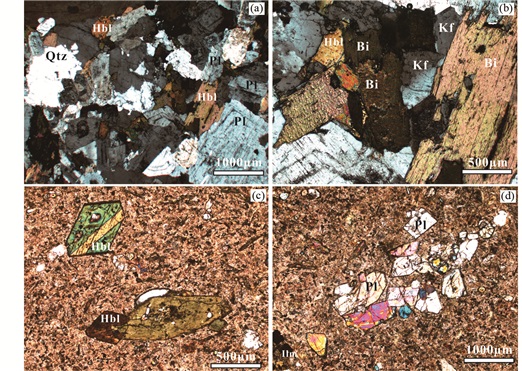
|
图 3 尼木曲林岩体花岗斑岩(a、b)及花岗闪长玢岩脉(c、d)显微照片 Pl-斜长石;Qtz-石英;Kf-钾长石;Hbl-角闪石;Bi-黑云母;Ilm-钛铁矿 Fig. 3 Microphotograph showing granite porphyry (a, b) and granodiorite porphyrite (c, d) of Qulin pluton in Nyemo Pl-plagioclase; Qtz-quartz; Kf-K-feldspar; Hbl-hornblende; Bi-biotite; Ilm-ilmenlite |
为了确定岩浆岩的形成年代,从代表性样品(花岗斑岩样品T0849-PG和T0849-G;花岗闪长玢岩脉样品T0848-PY和T0850)中挑选锆石, 经过手工挑选、制靶和抛光, 通过阴极发光(CL)揭示锆石的内部结构。CL成像在中国地质科学院地质研究所北京离子探针中心进行。根据CL图像,甄别锆石不同生长域的特征,选取U/Pb测试点。SHRIMP锆石U-Pb同位素定年测试在北京离子探针中心进行,所用仪器为高分辨率高灵敏度离子探针SHRIMP Ⅱ。测试前用锆石标样M257校正U的浓度,分析时标样为TEM锆石(206Pb/238U年龄=417Ma),每测定3个未知点,插入一次标样测定,以便及时校正,保障测试精度。
LA-ICP-MS锆石U-Pb同位素定年测试在中国地质科学院矿产资源研究所成矿作用与资源评价重点实验室完成。所用仪器为Neptune型激光多接收等离子体质谱(LA-MC-ICPMS),采用美国New Wave UP213nm激光剥蚀系统进样,激光剥蚀斑束直径为25μm,频率为10Hz,能量密度约为2.5J/cm2,以He为载气。U和Th含量的外标校正采用锆石标样M127(U=923×10-6; Th=439×10-6; Th/U=0.475)。在测试中, 每测定10个样品点前后重复测量两次锆石标样GJ-1和一次锆石标样Plesovice。分析数据的离线处理采用软件ICPMSDataCal完成(Liu et al., 2010),锆石年龄谐和图用Isoplot 3.0程序获得。
2.2 全岩元素地球化学测试曲林岩体的花岗斑岩和闪长岩脉的元素地球化学组成在国家地质实验测试研究中心进行。主量元素组成通过XRF(X荧光光谱仪3080E)方法测试分析精度为5%。通过等离子质谱仪(ICP-MS-Excell)分析微量元素和稀土元素(REE)含量,含量大于10×10-6的元素的测试精度为5%,小于10×10-6的元素精度为10%。含量较低的元素,测试误差大于10%。
2.3 全岩Sr-Nd同位素分析全岩Rb-Sr和Sm-Nd同位素组成在中国地质科学院地质研究所同位素实验室完成。采用同位素稀释法,Sr同位素组成及Rb、Sr、Sm和Nd的浓度利用Finnigan MAT-262质谱仪测试。Nd同位素分析利用Nu Plasam HR MC-ICP-MS多接受等离子质谱仪(Nu Instruments)。Nd和Sr分析结果质量分馏校正分别按146Nd/142Nd=0.7219和86Sr/88Sr=0.1194进行。Sr和Nd同位素测试标准分别为NBS987和JMCNd,样品测试期间的测试值分别为0.710247±12(2σ)和0.511127±12(2σ),测试精度分别为±0.000010(n=18)和±0.000011(n=18)。根据锆石U/Pb定年的结果,花岗斑岩样品和花岗闪长玢岩样品的Sr和Nd同位素的初始值分别按t=30Ma和t=15Ma计算。
2.4 锆石Hf同位素分析锆石Hf同位素测试在中国地质科学院地质研究所自然资源部深部动力学重点实验室开展,采样仪器为Nepture多接收等离子质谱和Newwave UP213紫外激光剥蚀系统(LA-MC-ICP-MS),实验过程中采用He作为剥蚀物质载气,剥蚀直径采用40μm,测定时使用锆石国际标样GJ1和Plesovice作为参考物质,分析点与U-Pb定年分析点为同一位置。相关仪器运行条件及详细分析流程见侯可军等(2007)。分析过程中锆石标准GJ1和Plesovice的176Hf/177Hf测试加权平均值分别为0.282007±0.000007(2σ,n=40)和0.282476±0.000004(2σ,n=25),与文献报道值(侯可军等, 2007; Morel et al., 2008; Sláma et al., 2008)在误差范围内完全一致。
3 结果 3.1 锆石U-Pb年龄和Hf同位素特征表 1、表 2列出了被测样品的锆石SHRIMP U-Pb及LA-ICP-MS定年结果,图 4为相对应的年龄谐和图。
|
|
表 1 藏南曲林岩体花岗斑岩(T0849-PG)及花岗闪长玢岩脉(T0850)锆石SHRIMP U-Pb同位素测试结果 Table 1 SHRIMP U-Pb analytical results of granite porphyry (T0849-PG) and granodiorite porphyrite (T0850) from Qulin pluton, southern Tibet |
|
|
表 2 藏南曲林岩体花岗斑岩(T0849-G)及花岗闪长玢岩(T0848-PY)锆石LA-ICP-MS U-Pb同位素测试结果 Table 2 LA-ICP-MS U-Pb analytical results of granite porphyry (T0849-G) and granodiorite porphyrite (T0848-PY) from Qulin pluton, southern Tibet |
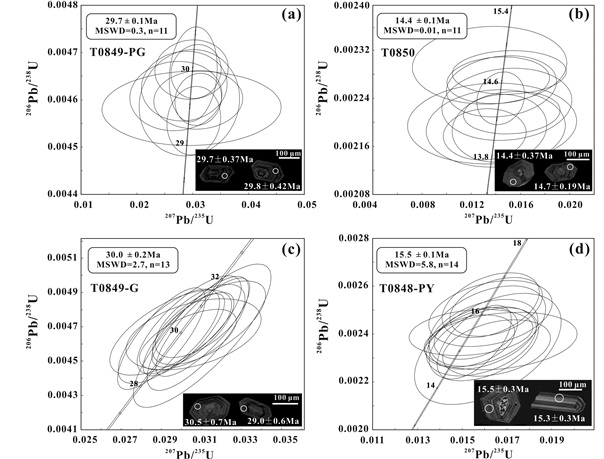
|
图 4 曲林岩体花岗斑岩和花岗闪长玢岩脉的锆石SHRIMP U-Pb定年谐和图(a、b)和LA-ICP-MS U-Pb定年谐和图(c、d) Fig. 4 SHRIMP (a, b) and LA-ICP-MS (c, d) zircon U-Pb concordia diagrams for granite porphyry and granodiorite porphyrite from Qulin pluton, respectively |
曲林花岗斑岩样品(T0849-PG和T0849-G)的锆石呈无色透明,均为柱状自行晶,晶棱晶面清晰,长轴约100~200μm,个别可达250μm,长宽比约为1:1~2:1,个别可达3:1。阴极发光图像显示很好的韵律环带,属于典型的岩浆锆石。在花岗斑岩样品T0849-PG中,12颗锆石U-Pb同位素分析结果揭示:1)它们的U含量为464×10-6~2100×10-6,Th为76×10-6~1006×10-6,Th/U比值较高,为0.17~0.54;2)206Pb/238U年龄变化范围为27.9~30.9Ma,剔除谐和度较差及离群值后,206Pb/238U年龄的加权平均值为29.7±0.1Ma(2σ;MSWD=0.32)。对另1件花岗斑岩样品T0849-G开展了LA-ICP-MS的锆石U-Pb测试,20颗锆石的分析结果表明:1)这些锆石的U含量为392×10-6~2899×10-6,Th含量为455×10-6~1815×10-6,Th/U比值也较高,为0.35~0.97;2)206Pb/238U年龄变化范围为28.1~42.9Ma,剔除谐和度较差及离群值后,加权平均值为30.0±0.2Ma(1σ;MSWD=2.7)。在实验误差范围内,2件花岗斑岩给出的U-Pb年龄相似,在~30Ma附近。高Th/U比值和典型的韵律结晶环带,表明这些锆石是从硅酸质熔体结晶的(Hoskin and Black, 2000), 因此,曲林岩体花岗斑岩的结晶年龄为~30Ma。
在花岗闪长玢岩脉样品T0848-PY中,大部分锆石为无色透明、自形-半自形、长柱状、棱角清晰,长度在100~200μm之间,个别可达250μm,长宽比一般为2:1,个别可达3:1。在阴极发光图像上,锆石都呈现出典型的韵律生长环带,为岩浆锆石。锆石的U和Th含量变化较大,分别在418×10-6~1294×10-6和266×10-6~2531×10-6之间,Th/U比值为0.51~1.96。去除谐和度较差及离群值后,锆石的U-Pb同位素年龄在误差范围内谐和,16个测试点年龄加权平均值为15.5±0.1Ma(图 4);另1件样品T0850的阴极发光图像上,锆石都呈现出典型的韵律生长环带,为岩浆锆石。锆石的U和Th含量分别在638×10-6~1836×10-6和437×10-6~952×10-6之间,Th/U比值为0.53~0.86。9个测试点年龄加权平均值为14.4±0.1Ma(图 4)。这2件样品具有典型的韵律生长环带和较高的Th/U比值,表明曲林岩体中的花岗闪长玢岩脉分别形成于15.5Ma(T048-PY)和14.4Ma(T0850)。
曲林岩体花岗斑岩及花岗闪长玢岩脉锆石Hf同位素组成分析结果见表 3。花岗斑岩样品(T0849-PG和T0849-G)的Hf同位素组成较均一,εHf(t)值在+4.9~+7.9之间(图 5),锆石Hf同位素的亏损地幔模式年龄(tDM)较年轻,为366~502Ma(表 3);花岗闪长玢岩脉样品(T0848-PY和T0850)的Hf同位素组成较均一,εHf(t)值在+2.2~+7.6之间(图 5),锆石Hf同位素的亏损地幔模式年龄(tDM)为383~596Ma(表 3)。
|
|
表 3 藏南曲林花岗斑岩及花岗闪长玢岩脉锆石Hf同位素分析结果 Table 3 Analytical results of zircon Hf isotopic compositions of the granite porphyry and granodiorite porphyrite from Qulin, Southern Tibet |

|
图 5 曲林花岗斑岩及花岗闪长玢岩脉的锆石εHf(t)对U-Pb年龄关系图 数据来源:晚渐新世-中新世(26~10Ma)高Sr/Y比岩浆岩(Chung et al., 2003; Hou et al., 2004; Gao et al., 2007, 2010; Guo et al., 2007a; Xu et al., 2010; Wang et al., 2015);冲木达渐新世高Sr/Y比岩浆岩(姜子琦等, 2011);程巴渐新世高Sr/Y比岩浆岩(尚振等, 2016).图 6-图 8数据来源及符号同此图 Fig. 5 Plot of zircon εHf(t) vs. U-Pb ages for the Qulin granite porphyry and granodiorite porphyrite Data source: Late Oligocene-Miocene (26~10Ma) high Sr/Y igneous rocks (Chung et al., 2003; Hou et al., 2004; Gao et al., 2007, 2010; Guo et al., 2007a; Xu et al., 2010; Wang et al., 2015). Oligocene high Sr/Y igneous rocks from Chongmuda and Chengba are from Jiang et al. (2011) and Shang et al. (2016), respectively. Data sources and symbols in Fig. 6-Fig. 8 are same as in this figure |
表 4列出了尼木渐新世花岗斑岩及中新世花岗闪长玢岩脉代表性样品的主量、微量和稀土元素测定结果及相关参数。
|
|
表 4 藏南曲林花岗斑岩及花岗闪长玢岩脉主量元素(wt%)和微量元素(×10-6)分析结果 Table 4 Analysis results of major element (wt%) and trace element (×10-6) of the granite porphyry and granodiorite porphyrite from Qulin, southern Tibet |
尼木曲林岩体花岗斑岩的SiO2较高,在66.98%~71.77%之间,Na2O为3.67%~4.19%,Na2O/K2O在0.8~1.3之间。在TAS图解中,主要落于亚碱性花岗岩区域(图 6a)。K2O较高,在3.29%~4.75%,在K2O-SiO2图解中,样品点落于高钾钙碱性岩区(图 6b)。铝饱和指数A/CNK为1.0~1.1,属于准铝质-弱过铝质系列(图 6c)。所有样品具有低MgO(0.63%~1.12%),低Cr(2.8×10-6~20.8×10-6),低Ni(3.2×10-6~11.6×10-6)含量的特征。
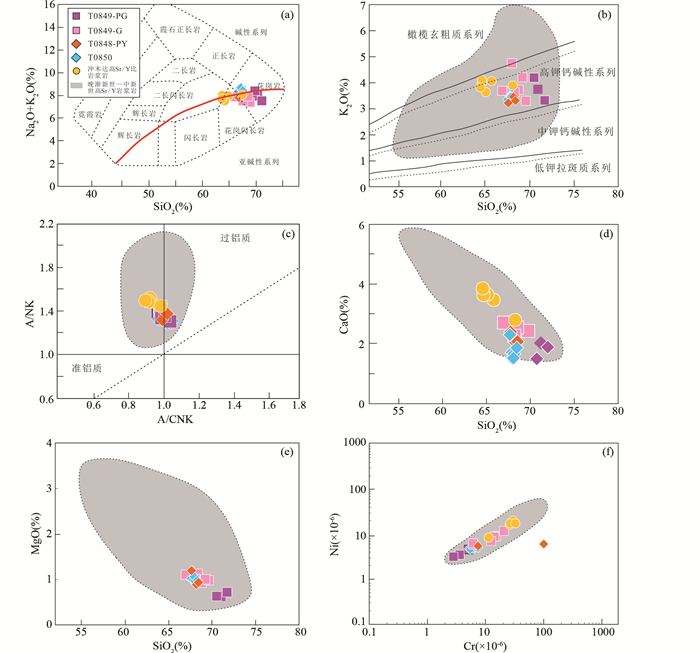
|
图 6 曲林岩体花岗斑岩及花岗闪长玢岩的主量元素图解 (a)岩浆岩分类图解(Middlemost, 1994);(b) K2O-SiO2分类图解(Peccerillo and Taylor, 1976);(c) A/NK-A/CNK分类图解(Maniar and Piccoli, 1989) Fig. 6 Selected major element plots for the Qulin granite porphyry and granodiorite porphyrite (a) classification diagram for igneous rocks (Middlemost, 1994); (b) K2O vs. SiO2 diagram (Peccerillo and Taylor, 1976); (c) A/NK vs. A/CNK diagram (Maniar and Piccoli, 1989) |
在球粒陨石标准化的稀土元素配分图中,花岗斑岩样品具有轻重稀土元素分馏明显的特征,富集LREE,亏损HREE(图 7a)。在原始地幔标准化的微量元素蛛网图中,花岗斑岩样品富集LILE,亏损HFSE(图 7b)。所有花岗斑岩样品均显示出高Ba含量(667×10-6~987×10-6),明显的Nb、Ta、Ti负异常(Nb/Ta=9~12)以及弱Eu负异常(Eu/Eu*=0.8~1.0),但未观察到Zr和Hf异常(Zr/Hf=33~43))。此外样品还具有高Sr、低Y和Yb,表现出高Sr/Y和(La/Yb)N的特点,指示花岗斑岩具有埃达克质岩的特征(图 8)。
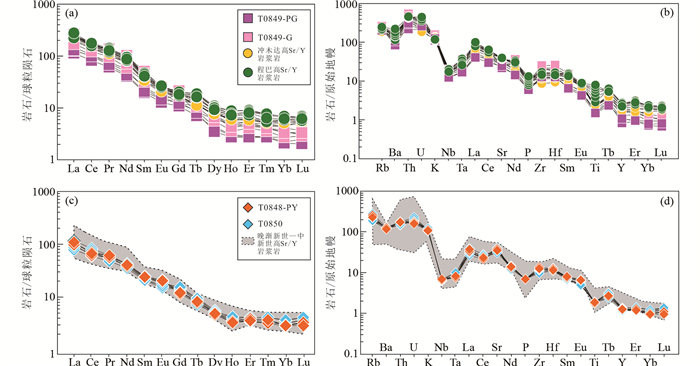
|
图 7 曲林岩体花岗斑岩及花岗闪长玢岩脉球粒陨石标准化稀土元素配分图解(a、c)及原始地幔标准化微量元素蛛网图(b、d)(标准化值据Sun and McDonough, 1989) Fig. 7 Chondrite-normalized rare earth element distribution patterns (a, c) and primitive mantle (PM)-normalized trace element (b, d) for the granite porphyry and granodiorite porphyrite from Qulin region (normalization values from Sun and McDonough, 1989) |
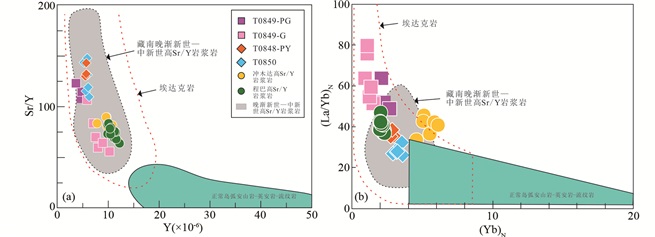
|
图 8 曲林岩体花岗斑岩及花岗闪长玢岩Sr/Y-Y (a)和(La/Yb)N-(Yb)N (b)关系图 埃达克岩及正常岛弧安山岩-英安岩-流纹岩的范围分别据Defant and Drummond (1990)和Petford and Atherton (1996). N表示由球粒陨石标准化值(据Sun and McDonough, 1989) Fig. 8 Plots of Sr/Y vs. Y (a) and (La/Yb)N vs. YbN (b) for the Qulin granite porphyry and granodiorite porphyrite Fields of adakite and arc magmatic rocks are from Defant and Drummond (1990) and Petford and Atherton (1996), respectively. Values normalized to chondrite composition denoted by N are from Sun and McDonough (1989) |
尼木曲林花岗闪长玢岩脉表现出以下地球化学特征:与花岗斑岩相比,SiO2(67.56%~68.42%)和K2O(3.23%~3.82%)较低,但Na2O(4.57%~5.20%)和Na2O/K2O(1.2~1.5)较高。在TAS图解中,主要落于亚碱性花岗闪长岩区(图 6a)。在K2O-SiO2图解中,样品点落于高钾钙碱性岩区(图 6b)。铝饱和指数A/CNK在1.0~1.1,属于准铝质-弱过铝质系列(图 6c)。花岗闪长玢岩样品同样具有低MgO(0.89%~1.20%),低Cr(5.2×10-6~26.7×10-6),低Ni(4.8×10-6~18.0×10-6)含量的特征。
在球粒陨石标准化的稀土元素配分图中,花岗闪长玢岩脉样品同样具有轻重稀土元素分馏显著的特征,富集LREE,亏损HREE (图 7c)。在原始地幔标准化的微量元素蛛网图中,花岗闪长玢岩样品富集LILE,亏损HFSE (图 7d)。所有花岗闪长玢岩样品均显示出高Ba含量(824×10-6~924×10-6)和明显的Nb、Ta、Ti负异常(Nb/Ta=12~15),但未显示Zr、Hf异常(Zr/Hf=31~40)。此外样品还具有高Sr、低Y和Yb,表现出高Sr/Y和(La/Yb)N,表明花岗闪长玢岩脉同样具有埃达克质岩的特征(图 8)。
3.3 全岩Sr-Nd特征曲林花岗斑岩及花岗闪长玢岩脉的初始同位素比值分别基于其平均结晶年龄计算而得。全岩Sr和Nd同位素组成数据见表 5。曲林花岗斑岩的初始87Sr/86Sr比值较高,为0.706102~0.706201,初始143Nd/144Nd比值为0.512545~0.512609,εNd(t)值为-0.64~+0.63,Nd模式年龄tDM为0.63~0.78Ga(表 5、图 9)。花岗闪长玢岩脉的初始87Sr/86Sr比值为0.705429~0.705474,初始143Nd/144Nd比值为0.512534~0.512599,εNd(t)值为-1.4~-0.2,Nd模式年龄tDM为0.82~0.91Ga(表 5、图 9)。上述数据表明,花岗斑岩和花岗闪长玢岩源区的Sr-Nd演化趋势不同。
|
|
表 5 藏南曲林花岗斑岩及花岗闪长玢岩脉Sr-Nd同位素组成 Table 5 Sr-Nd isotope composition of the granite porphyry and granodiorite porphyrite from Qulin, southern Tibet |
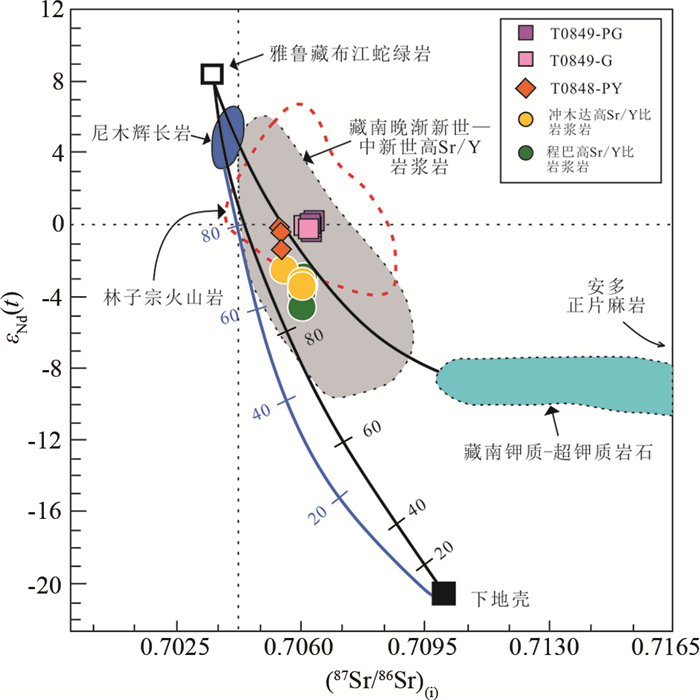
|
图 9 曲林岩体花岗斑岩及花岗闪长玢岩εNd(t)-87Sr/86Sr(i)图解 数据来源:高Sr/Y岩浆岩同图 5;尼木辉长岩及苏长岩(Ji et al., 2009; Wang et al., 2019);雅鲁藏布江洋中脊玄武岩(Mahoney et al., 1998);古老下地壳(Miller et al., 1999) Fig. 9 εNd(t) vs. 87Sr/86Sr(i) values diagram of granite porphyry and granodiorite porphyrite from Qulin pluton Data source: High Sr/Y igneous rocks are same as Fig. 5. Gabbro and norite from Nyemo (Ji et al., 2009; Wang et al., 2019). Yarlung MORB (Mahoney et al., 1998); and ancient lower crust (Miller et al., 1999) |
上述数据表明:花岗斑岩和花岗闪长玢岩的源区具有弱富集属性,其岩浆组分可能包含新生地壳物质。
4 讨论 4.1 年代学尼木曲林岩体花岗斑岩及花岗闪长玢岩脉的锆石都具有良好的韵律环带,为岩浆锆石,获得的锆石U-Pb年龄应代表这些侵入岩的结晶年龄。因此,曲林花岗斑岩及花岗闪长玢岩脉的年龄分别为~30Ma和15.5~14.4Ma。此外,被曲林岩体侵入的的辉长岩年龄均为~57.3Ma(Ji et al., 2009, 2012; Wang et al., 2019)。曲林岩体中的花岗斑岩和花岗闪长玢岩脉及附近基性岩的结晶年龄正好对应着自印度-欧亚大陆碰撞以来,冈底斯岩基经历的三阶段主要构造岩浆作用(Wen et al., 2008a, b; Ji et al., 2009, 2012; Wang et al., 2019)。
4.2 高Sr/Y比岩浆岩成因“埃达克岩”的概念已被广泛应用于具有高Sr/Y比和高(La/Yb)N比的中酸性岩浆岩,但这些岩石的其它地球化学性质及成因却不尽相同。形成高Sr/Y比岩浆岩的方式可以是部分熔融、分离结晶或者与熔体-地幔相互作用。高Sr/Y岩浆岩在拉萨地块中成带状广泛分布,与雅鲁藏布江缝合带近平行展布。在冈底斯岩基,已报道的高Sr/Y比岩浆岩年龄大致在137~9Ma之间(Yin et al., 1994; Williams et al., 2001, 2004; Chung et al., 2003, 2005, 2009; Hou et al., 2004, 2012, 2015; Qu et al., 2004; Guo et al., 2007a; Guan et al., 2012; Xu et al., 2010; 姜子琦等, 2011; Jiang et al., 2014; Zheng et al., 2012; Ma et al., 2014; Chen et al., 2015a; 徐倩等, 2019a, b)。这些岩石的产生与新特提斯大洋板片的俯冲、印度-亚洲大陆碰撞以及后碰撞时期的构造运动有关。
高Sr/Y岩浆岩的成因大致可分为几种情况:俯冲背景下大洋板片的熔融(Defant and Drummond, 1990; Kay and Mahlburg Kay, 1993);拆沉下地壳的熔融(Wang et al., 2004, 2006; Xu et al., 2006);较基性岩浆的分离结晶作用(Castillo et al., 1999; Castillo, 2012; Macpherson et al., 2006; 王莉等, 2012;尚振等, 2016);长英质与基性岩浆的混合作用(Guo et al., 2007b; Streck et al., 2007);或增厚基性下地壳的部分熔融(Chung et al., 2003; Hou et al., 2004; Guo et al., 2007a; He et al., 2011; Zeng et al., 2011; Guan et al., 2012)。且高Sr/Y比岩石的构造背景也并不单一,例如俯冲环境、板块内部伸展环境及陆-陆碰撞造山带等。就已报道的冈底斯带早渐新世(33~30Ma)及晚渐新世-中新世(26~10Ma)高Sr/Y比岩浆岩而言,其成因仍存较大争议。冈底斯岩基内从西至东呈带状广泛分布着时代为26~10Ma的高Sr/Y比岩浆岩(Chung et al., 2003, 2005, 2009; Hou et al., 2004, 2012; Guo et al., 2007a; Xu et al., 2010; Guan et al., 2012; Zheng et al., 2012)。除本文报道的尼木地区外,仅有卧龙、努日和冲木达-程巴发育36~30Ma的高Sr/Y岩浆岩(Harrison et al., 2000; Chung et al., 2009; 姜子琦等, 2011; Hou et al., 2012; Guan et al., 2012; Chen et al., 2015a; 尚振等, 2016)。
俯冲环境下洋壳熔融形成的高Sr/Y比岩浆岩一般具有低K2O及与洋中脊玄武岩相近的Sr-Nd同位素特征(Defant and Drummond, 1990; Kay and Mahlburg Kay, 1993; 高永丰等, 2003; Gao et al., 2007, 2010),而曲林高Sr/Y比花岗斑岩及花岗闪长玢岩脉均具有高K2O,较高的初始87Sr/86Sr值及低εNd值,这些特征与由板片产生的高Sr/Y比岩浆岩具有很大的差别(图 9)。同时在~30Ma时期,冈底斯岩基已经处于碰撞造山环境,不存在俯冲洋壳部分熔融的可能性,因此曲林高Sr/Y比花岗斑岩及花岗闪长玢岩脉不太可能由俯冲的新特提斯洋板片熔融而成。
拆沉下地壳熔融同样能够形成高Sr/Y岩浆岩(Wang et al., 2004, 2006; Xu et al., 2006)。但就冈底斯带南缘而言,通过这种方式产生的高Sr/Y岩浆在上涌过程中势必会与上覆地幔楔发生反应,导致岩浆具有高MgO、Cr和Ni的特征(Stern and Hanson, 1991)。且拉萨地块下部增厚下地壳拆沉部分熔融所形成的岩石应具有更高的εHf(t)及εNd(t)的同位素特征(Ji et al., 2009)。所以曲林花岗斑岩也不是由拆沉下地壳熔融而形成的。
较基性岩浆的分离结晶也是一种产生高Sr/Y比岩浆岩的方式(Castillo et al., 1999; Castillo, 2012; Macpherson et al., 2006; 王莉等, 2012; 尚振等, 2016)。曲林高Sr/Y比花岗斑岩及花岗闪长玢岩脉的地球化学组成表明其形成过程中经历了部分熔融而非高压条件下含石榴子石的分离结晶作用(Macpherson et al., 2006)(图 7)。高压条件下石榴子石发生的分离结晶作用会使得岩浆具有(La/Yb)N与SiO2强相关的特征(Macpherson et al., 2006),但如图(La/Yb)N-SiO2显示,当SiO2浓度一定时,(La/Yb)N变化范围较大,且未表现出与SiO2的强相关性(图 10d)。Castillo et al. (1999)认为基性岩浆的同化混染以及低压条件下角闪石±斜长石的分离结晶作用可产生高Sr/Y比岩浆岩。但(Dy/Yb)N和(La/Yb)N呈正相关表明角闪石的分离结晶对于曲林花岗斑岩及花岗闪长玢岩而言并未起到至关重要的作用(图 10a)。Eu弱负异常可能归因于岩浆源区有斜长石残留相或者斜长石分离结晶。这些岩石具有高Sr和高Ba含量,可以基本排除大量斜长石分离结晶的可能性,同时,在部分熔融中,斜长石是主要反应相,也不太可能作为主要残留矿物相滞留在源区中(图 7)。此外,高SiO2的岩浆中存在诸如锆石、磷灰石等副矿物。如果这些矿物相发生分离结晶作用,会消耗岩浆中重稀土元素和中度不相容元素,增强岩浆岩亏损HREE的特征。在P/P*与MgO之间不显示明显的相关性,表明在这些岩浆演化过程中,磷灰石分离结晶作用不重要(图 10e, f)(Guo et al., 2005, 2006)。锆石的分离结晶作用能够增大(La/Yb)N比和(Dy/Yb)N比(Bea et al., 1994),但是花岗斑岩及花岗闪长玢岩样品中(Dy/Yb)N与Zr并无相关性,因此锆石不是造成样品(Dy/Yb)N高的决定性因素。
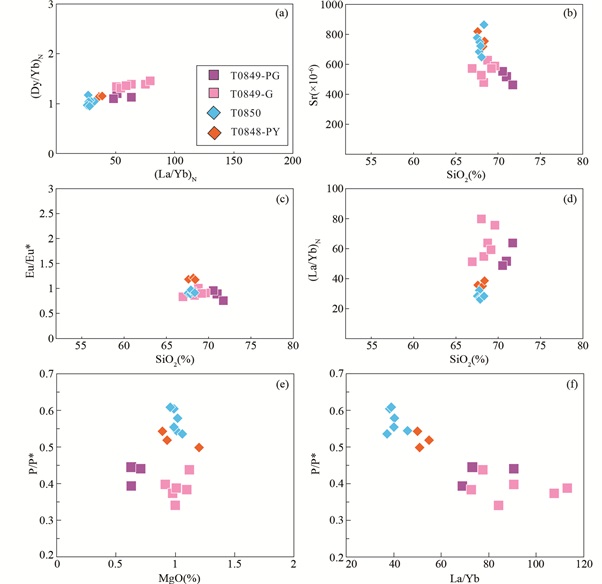
|
图 10 曲林岩体花岗斑岩及花岗闪长玢岩的(Dy/Yb)N-(La/Yb)N (a)、Sr-SiO2 (b)、(Eu/Eu*)-SiO2 (c)、(La/Yb)N-SiO2 (d)、P/P*-MgO (e)和P/P*-La/Yb (f)关系图 Fig. 10 Plots of (Dy/Yb)N vs. (La/Yb)N (a), Sr vs. SiO2 (b), (Eu/Eu*) vs. SiO2 (c), (La/Yb)N vs. SiO2 (d), P/P* vs. MgO (e) and P/P* vs. La/Yb (f) of granite porphyry and granodiorite porphyrite from Qulin pluton |
曲林高Sr/Y比岩浆岩与钾质-超钾质火成岩在时间和空间上存在联系,但相较于钾质-超钾质火成岩,高Sr/Y比岩浆岩具有更低的87Sr/86Sr、大离子亲石元素(LILE)和K2O含量以及更高的143Nd/144Nd(Miller et al., 1999),因此通过同化混染和分离结晶作用(AFC),基性钾质-超钾质岩浆岩不可能形成曲林高Sr/Y比岩浆。
长英质与基性岩浆的混合作用也是形成高Sr/Y比岩浆岩的作用之一(Guo et al., 2007b; Streck et al., 2007)。但是来源于岩浆混合作用产生的高Sr/Y比岩浆岩具有高MgO和Mg#的特征,与曲林花岗斑岩的地球化学特征不相符。区域内没有出露同期基性岩,且曲林高Sr/Y比花岗斑岩与花岗闪长玢岩中未发现辉石。此外,岩体主体花岗斑岩与其暗色包体的εHf(t)相近(+4.9~+8.3),且包体的εHf(t)值变化范围较小(作者,未出版),约3个ε单位,Hf同位素组成的均一性也不支持长英质与基性岩浆混合的假设(Guo et al., 2007b; Streck et al., 2007)。
有研究认为冈底斯岩基内早渐新世(33~30Ma)高Sr/Y岩浆岩可能是印度俯冲板片下地壳部分熔融的产物(Xu et al., 2010; 姜子琦等, 2011; Jiang et al., 2014; Chen et al., 2015a)。熔体从俯冲的印度下地壳产生之后会与上覆岩石圈地幔作用,产生具有高MgO、Cr和Ni的高Sr/Y岩浆岩,而这与曲林高Sr/Y花岗斑岩[MgO(< 1.12%)、Cr(< 20.8×10-6)、Ni(< 11.6×10-6)]及花岗闪长玢岩脉[MgO(< 1.20%)、Cr(< 26.7×10-6)、Ni(< 18×10-6)]地球化学特征不相符。如果熔体从俯冲印度下地壳产生后并未与上覆地幔充分反应,应该保留初始俯冲陆壳的地球化学特征,那么应与被认为由印度下地壳熔融形成的北喜马拉雅始新世高Sr/Y淡色花岗岩的地球化学特征一致(高利娥等, 2009; Zeng et al., 2011),而其同位素特征为87Sr/86Sr(i)(0.711942~0.718847),εNd(t)(-14.9~-9.8),εHf(t)(>-6)(Zeng et al., 2011)。这与本文花岗斑岩(87Sr/86Sr(i)=0.706102~0.706202,εNd(t)=-0.6~+0.6,εHf(t)=+4.9~+8.3)及花岗闪长玢岩脉(87Sr/86Sr(i)=0.705409~0.705474,εNd(t)=-1.4~-0.1,εHf(t)=+2.1~+6.2)的同位素特征差别较大。因此,曲林高Sr/Y花岗斑岩不是由俯冲背景下印度下地壳部分熔融而形成的。
根据曲林岩体高Sr/Y花岗斑岩及花岗闪长玢岩脉的地球化学数据特征(MgO、Cr、Ni较低和K2O较高),并结合先前已报道的拉萨地块内高Sr/Y岩浆岩的地球化学数据(Chung et al., 2003; Hou et al., 2004; Guo et al., 2007a; Xu et al., 2010; 姜子琦等, 2011; Guan et al., 2012; Zheng et al., 2012),曲林岩体花岗斑岩及花岗闪长玢岩脉最可能是加厚镁铁质拉萨下地壳部分熔融而形成的。
曲林高Sr/Y花岗斑岩的87Sr/86Sr(i)为(0.706102~0.706202),εNd(t)值为(-0.6~+0.6),与冈底斯岩基40~60Ma的基性岩浆岩的Sr和Nd同位素特征相近,也支持花岗斑岩的源区是下地壳物质。火成岩中锆石可较好地保持初始177Hf/176Hf比不变,与全岩Nd同位素相似,锆石Hf同位素组成也是示踪岩浆源区的良好指标。花岗斑岩和花岗闪长玢岩样品的锆石εHf(t)值均为正值,且具有相对较年轻的二阶段Hf模式年龄(表 3),指示其源区明显的亏损属性。锆石的正εHf(t)值(+4.9~+8.3)也表明初生的与俯冲相关的物质对于曲林高Sr/Y岩浆岩形成的贡献较大,支持基于Sr-Nd同位素特征的推论。如果假设高Sr/Y比岩浆由两端元物质组成,即亏损地幔和古老西藏下地壳(Miller et al., 1999),并由雅鲁藏布江洋中脊玄武岩(MORB)代表亏损地幔。如图εNd(t)-87Sr/86Sr(i)显示(图 9),来自曲林岩体的高Sr/Y比岩浆岩的值均落在亏损地幔与西藏下地壳的端元混合线上或混合线附近,表明这些高Sr/Y比岩浆岩主要来自于拉萨下地壳的部分熔融并伴随少量的幔源物质的贡献。
4.3 高Sr/Y比岩浆岩的源区性质与来自亏损地幔的岩浆岩相比,曲林花岗斑岩具有较低的εNd(t)值(-0.6~+0.6)和εHf(t)值(+5.0~+7.5),而与冲木达-程巴高Sr/Y比岩浆岩(εNd(t)=-3.3~-2.5)(姜子琦等, 2011; 尚振等, 2016)相比,曲林花岗斑岩的Nd同位素组成高3个εNd单位, 岩浆源区的富集组分明显少于冲木达-程巴花岗质岩体,表明来自俯冲印度大陆岩石圈的贡献不明显,因此,曲林渐新世高Sr/Y花岗斑岩的源区主要为冈底斯岩基下地壳物质。
尼木曲林岩体内花岗闪长玢岩脉形成时代为15~14Ma,具有弱负的εNd(t)值(-1.4~-0.2)和正的εHf(t)值(+2.2~+5.3),与冈底斯同期Sr/Y比岩浆岩的地球化学特征及同位素特征相近,表明曲林中新世花岗闪长玢岩脉同样是来自冈底斯岩基下地壳的部分熔融。与~30Ma花岗斑岩相比,中新世花岗闪长玢岩的源区具有更富集的特征,表现为Nd和Hf同位素组成的降低,这可能预示着在30Ma至15Ma期间,冈底斯岩基的下地壳经历了弱富集作用。
高Sr/Y比岩浆岩的微量元素特征可较好地指示源区矿物组成。Huang and He (2010)提出相较于Sr/Y比和(La/Yb)N比,(Dy/Yb)N比更能指示岩浆源区中是否存在石榴子石。虽然(Dy/Yb)N比与(La/Yb)N比呈正相关关系,La/Yb和Sr/Y比值较高,但较平坦的HREE配分模式表明,在下地壳部分熔融过程中,角闪石是主要的源区残留相,而不是石榴子石(图 7、图 10a)。花岗斑岩和花岗闪长玢岩脉均富含Sr以及Sr与SiO2具有强相关性排除了熔融残留相中含大量斜长石的可能,而弱Eu负异常的特征表明源区内很可能含少量斜长石相(图 10b, c)。虽然仍不能排除部分熔融过程中含Ti矿物(金红石和榍石)的效应(Foley et al., 2000, 2002; Prowatke and Klemme, 2005; Nair and Chacko, 2008),花岗斑岩及花岗闪长玢岩脉中Nb-Ta负异常(图 7)更可能是继承源区的特征。
5 动力学意义青藏高原下地壳增厚机制一直是众多学者关注的科学问题之一(Ding et al., 2003; Wen et al., 2008b; Zhu et al., 2017)。岛弧或后碰撞构造岩浆作用形成岩浆的地球化学特征(如HREE含量)与地壳厚度之间具有很好的相关性(Haschke et al., 2002; Chapman et al., 2015; Profeta et al., 2015; Hu et al., 2017)。因此,LREE/HREE比值的最大值可估算高Sr/Y岩浆岩形成时的大陆地壳厚度,来限定大陆地壳的演化模式(Haschke et al., 2002; Chung et al., 2009; Hu et al., 2017)。结合文献数据,依据曲林高Sr/Y比岩浆岩的(La/Yb)N比值,冈底斯岩基自40Ma以来的地壳厚度变化显示在图 11中。从图中可以观察到,(La/Yb)N在晚渐新世-中新世(ca. 30~10Ma)有小幅度降低的趋势,表明此时代区间内地壳在一定程度上减薄,这可能与~30Ma增厚下地壳拆沉,深部岩石圈发生减薄有关。

|
图 11 藏南晚始新世-中新世高Sr/Y岩浆岩的(La/Yb)N与U-Pb年龄的关系图 数据来源:晚始新世-晚渐新世(ca. 40~30Ma)高Sr/Y比岩浆岩(姜子琦等, 2011; Guan et al., 2012; Ji et al., 2012; Chen et al., 2015a; 尚振等, 2016);晚渐新世-中新世(26~10Ma)高Sr/Y比岩浆岩同图 5.地壳厚度相关性基于安第斯山脉的研究(Haschke et al., 2002; Kay and Kay, 2002) Fig. 11 Plot of (La/Yb)N vs. U-Pb age for the Late Eocene-Miocene high Sr/Y igneous rocks in southern Tibet Data sources: Late Eocene-Late Oligocene (ca. 40~30Ma) high Sr/Y igneous rocks (Jiang et al., 2011; Guan et al., 2012; Ji et al., 2012; Chen et al., 2015a; Shang et al., 2016); Late Oligocene-Miocene (26~10Ma) high Sr/Y igneous rocks are same as Fig. 5. The crustal thickness correlation is based on Andean researches (Haschke et al., 2002; Kay and Kay, 2002) |
在后碰撞阶段,增厚岩石圈的拆沉或撕裂都可能导致深部软流圈地幔上涌,加热大陆岩石圈地幔或下地壳,导致较富集组分发生部分熔融。在冈底斯岩基,富集岩石圈地幔的部分熔融形成钾质-超钾质岩浆岩,基性下地壳部分熔融形成高Sr/Y比中酸性岩浆。较早期的来源于大陆岩石圈地幔的钾质-超钾质岩浆也有可能改造冈底斯岩基下地壳物质(Guo et al., 2007a),导致曲林中新世高Sr/Y岩浆岩具有更富集的特征。
从渐新世到中新世,冈底斯岩基中段可能经历了以下构造岩浆作用。
阶段-1:33~26Ma新特提斯大洋板片的断裂之后,印度大陆板块以较小的角度及较慢的速度俯冲至拉萨地块之下(Guillot et al., 2008),大陆之间的硬碰撞使得冈底斯弧岩浆活动在约40~25Ma出现间歇(Mahéo et al., 2002; Chung et al., 2005)。除了本文报道的曲林岩体外,其他包括卧龙~36Ma高Sr/Y比花岗岩(Ji et al., 2009; Guan et al., 2012),~35Ma曲果沙岩体(Ma et al., 2017),ca. 34~30Ma努日岩体(Chen et al., 2015a)和~30Ma程巴复合岩体(Ji et al., 2009; Chung et al., 2009; Harrison et al., 2000; Hou et al., 2012; 尚振等, 2016)。与冲木达和程巴高Sr/Y比岩浆岩相比,曲林花岗斑岩具有更高的εNd(t)值和更低的MgO、Cr、Ni含量及εHf(t)值,不太可能来源于俯冲印度下地壳的熔融。这种区域上高Sr/Y比岩浆岩的主量元素、微量元素及同位素组成的差异,很可能与岩浆源区的性质有关。
阶段-2:26~10Ma在该阶段,西藏南部经历了东西向和南北向伸展作用(Yin, 2000; Ratschbacher et al., 2011; Cooper et al., 2015; Xu et al., 2020),形成钾质-超钾质(Turner et al., 1996; Miller et al., 1999; Williams et al., 2001; Zhao et al., 2009; Guo et al., 2015)以及高Sr/Y比中酸性岩浆活动(Chung et al., 2003; Hou et al., 2004; Guo et al., 2007a; Xu et al., 2010; Zheng et al., 2012; 徐倩等, 2019b)。晚渐新世深部岩石圈的拆沉(Turner et al., 1996; Miller et al., 1999; Chung et al., 2003, 2005; Chen et al., 2017)或俯冲印度板块的撕裂(~25-10Ma)(Yin, 2000; Mahéo et al., 2002; Chen et al., 2015b; Liang et al., 2016; Wu et al., 2019),这些过程都可诱发热的软流圈物质上涌,加热大陆岩石圈地幔或下地壳,导致较富集组分发生部分熔融。在冈底斯岩基,富集岩石圈地幔的部分熔融形成高钾-超钾质岩浆岩,基性下地壳部分熔融形成高Sr/Y比中酸性岩浆。
6 结论(1) 曲林岩体的主体-花岗斑岩的结晶年龄为约30Ma,形成于早渐新世。岩体的2条花岗闪长玢岩脉的结晶年龄分别为约15.5Ma和约14.4Ma,形成于中新世。
(2) 曲林花岗斑岩及花岗闪长玢岩脉均显示出高Sr/Y、高(La/Yb)N比值的化学特征,可能来源于加厚新生拉萨下地壳的部分熔融。
(3) 增厚岩石圈的拆沉或俯冲印度岩石圈的撕裂诱发软流圈上涌,促使增厚下地壳部分熔融,形成高Sr/Y比中酸性岩石。
致谢 感谢赵志丹教授、孟繁聪研究员和纪伟强副研究员提出宝贵修改意见。
Bea F, Pereira MD and Stroh A. 1994. Mineral/leucosome trace-element partitioning in a peraluminous migmatite (a laser ablation-ICP-MS study). Chemical Geology, 117(1-4): 291-312 DOI:10.1016/0009-2541(94)90133-3 |
Castillo PR, Janney PE and Solidum RU. 1999. Petrology and geochemistry of Camiguin Island, southern Philippines:Insights to the source of adakites and other lavas in a complex arc setting. Contributions to Mineralogy and Petrology, 134(1): 33-51 DOI:10.1007/s004100050467 |
Castillo PR. 2012. Adakite petrogenesis. Lithos, 134-135: 304-316 DOI:10.1016/j.lithos.2011.09.013 |
Chapman JB, Ducea MN, DeCelles PG and Profeta L. 2015. Tracking changes in crustal thickness during orogenic evolution with Sr/Y:An example from the North American Cordillera. Geology, 43(10): 919-922 DOI:10.1130/G36996.1 |
Chen JL, Xu JF, Zhao WX, Dong YH, Wang BD and Kang ZQ. 2011. Geochemical variations in Miocene adakitic rocks from the western and eastern Lhasa terrane:Implications for lower crustal flow beneath the Southern Tibetan Plateau. Lithos, 125(3-4): 928-939 DOI:10.1016/j.lithos.2011.05.006 |
Chen JS, Huang BC and Sun LS. 2010. New constraints to the onset of the India-Asia collision:Paleomagnetic reconnaissance on the Linzizong Group in the Lhasa Block, China. Tectonophysics, 489(1-4): 189-209 DOI:10.1016/j.tecto.2010.04.024 |
Chen L, Qin KZ, Li GM, Li JX, Xiao B, Zhao JX and Fan X. 2015a. Zircon U-Pb ages, geochemistry, and Sr-Nd-Pb-Hf isotopes of the Nuri intrusive rocks in the Gangdese area, southern Tibet:Constraints on timing, Petrogenesis, and tectonic transformation. Lithos, 212-215: 379-396 DOI:10.1016/j.lithos.2014.11.014 |
Chen M, Niu FL, Tromp J, Lenardic A, Lee CTA, Cao WR and Ribeiro J. 2017. Lithospheric foundering and underthrusting imaged beneath Tibet. Nature Communications, 8(1): 15659 DOI:10.1038/ncomms15659 |
Chen Y, Li W, Yuan XH, Badal J and Teng JW. 2015b. Tearing of the Indian lithospheric slab beneath southern Tibet revealed by SKS-wave splitting measurements. Earth and Planetary Science Letters, 413: 13-24 DOI:10.1016/j.epsl.2014.12.041 |
Chung SL, Liu DY, Ji JQ, Chu MF, Lee HY, Wen DJ, Lo CH, Lee TY, Qian Q and Zhang Q. 2003. Adakites from continental collision zones:Melting of thickened lower crust beneath southern Tibet. Geology, 31(11): 1021-1024 DOI:10.1130/G19796.1 |
Chung SL, Chu MF, Zhang YQ, Xie YW, Lo CH, Lee TY, Lan CY, Li XH, Zhang Q and Wang YZ. 2005. Tibetan tectonic evolution inferred from spatial and temporal variations in post-collisional magmatism. Earth-Science Reviews, 68(3-4): 173-196 |
Chung SL, Chu MF, Ji JQ, O'Reilly SY, Pearson NJ, Liu DY, Lee TY and Lo CH. 2009. The nature and timing of crustal thickening in Southern Tibet:Geochemical and zircon Hf isotopic constraints from postcollisional adakites. Tectonophysics, 477(1-2): 36-48 DOI:10.1016/j.tecto.2009.08.008 |
Cooper FJ, Hodges KV, Parrish RR, Roberts NMW and Horstwood MSA. 2015. Synchronous N-S and E-W extension at the Tibet-to-Himalaya transition in NW Bhutan. Tectonics, 34(7): 1375-1395 DOI:10.1002/2014TC003712 |
Defant MJ and Drummond MS. 1990. Derivation of some modern arc magmas by melting of young subducted lithosphere. Nature, 347(6294): 662-665 DOI:10.1038/347662a0 |
Ding L, Kapp P, Zhong DL and Deng WM. 2003. Cenozoic volcanism in Tibet:Evidence for a transition from oceanic to continental subduction. Journal of Petrology, 44(10): 1833-1865 DOI:10.1093/petrology/egg061 |
Ding L, Xu Q, Yue YH, Wang HQ, Cai FL and Li S. 2014. The Andean-type Gangdese Mountains:Paleoelevation record from the Paleocene-Eocene Linzhou Basin. Earth and Planetary Science Letters, 392: 250-264 DOI:10.1016/j.epsl.2014.01.045 |
Dong GC, Mo XX, Zhao ZD, Zhu DC, Wang LL, Chen T and Li B. 2006. Magma mixing in middle part of Gangdise magma belt:Evidences from granitoid complex. Acta Petrologica Sinica, 22(4): 835-844 (in Chinese with English abstract) DOI:10.1016/j.sedgeo.2005.11.021 |
Foley SF, Barth MG and Jenner GA. 2000. Rutile/melt partition coefficients for trace elements and an assessment of the influence of rutile on the trace element characteristics of subduction zone magmas. Geochimica et Cosmochimica Acta, 64(5): 933-938 DOI:10.1016/S0016-7037(99)00355-5 |
Foley SF, Tiepolo M and Vannucci R. 2002. Growth of early continental crust controlled by melting of amphibolite in subduction zones. Nature, 417(6891): 837-840 DOI:10.1038/nature00799 |
Gao LE, Zeng LS, Liu J and Xie KJ. 2009. Early oligocene Na-rich peraluminous leucogranites in the Yardoi gneiss dome, southern Tibet:Formation mechanism and tectonic implications. Acta Petrologica Sinica, 25(9): 2289-2302 (in Chinese with English abstract) |
Gao YF, Hou ZQ and Wei RH. 2003. Neogene porphyries from Gangdese:Petrological, geochemical characteristics and geodynamic significances. Acta Petrologica Sinica, 19(3): 418-428 (in Chinese with English abstract) DOI:10.1016/S0037-0738(02)00333-0 |
Gao YF, Hou ZQ, Kamber BS, Wei RH, Meng XJ and Zhao RS. 2007. Adakite-like porphyries from the southern Tibetan continental collision zones:Evidence for slab melt metasomatism. Contributions to Mineralogy and Petrology, 153(1): 105-120 DOI:10.1007/s00410-006-0137-9 |
Gao YF, Yang ZS, Santosh M, Hou ZQ, Wei RH and Tian SH. 2010. Adakitic rocks from slab melt-modified mantle sources in the continental collision zone of southern Tibet. Lithos, 119(3-4): 651-663 DOI:10.1016/j.lithos.2010.08.018 |
Guan Q, Zhu DC, Zhao ZD, Dong GC, Zhang LL, Li XW, Liu M, Mo XX, Liu YS and Yuan HL. 2012. Crustal thickening prior to 38Ma in southern Tibet:Evidence from lower crust-derived adakitic magmatism in the Gangdese Batholith. Gondwana Research, 21(1): 88-99 DOI:10.1016/j.gr.2011.07.004 |
Guillot S, Mahéo G, de Sigoyer J, Hattori KH and Pêcher A. 2008. Tethyan and Indian subduction viewed from the Himalayan high-to ultrahigh-pressure metamorphic rocks. Tectonophysics, 451(1-4): 225-241 DOI:10.1016/j.tecto.2007.11.059 |
Guo F, Nakamuru E, Fan WM, Kobayoshi K and Li CW. 2007b. Generation of palaeocene adakitic andesites by magma mixing; Yanji Area, NE China. Journal of Petrology, 48(4): 661-692 DOI:10.1093/petrology/egl077 |
Guo ZF, Hertogen J, Liu JQ, Pasteels P, Boven A, Punzalan L, He HY, Luo XJ and Zhang WH. 2005. Potassic magmatism in western Sichuan and Yunnan provinces, SE Tibet, China:Petrological and geochemical constraints on petrogenesis. Journal of Petrology, 46(1): 33-78 DOI:10.1093/petrology/egh061 |
Guo ZF, Wilson M, Liu JQ and Mao Q. 2006. Post-collisional, Potassic and ultrapotassic magmatism of the Northern Tibetan Plateau:Constraints on characteristics of the mantle source, geodynamic setting and uplift mechanisms. Journal of Petrology, 47(6): 1177-1220 DOI:10.1093/petrology/egl007 |
Guo ZF, Wilson M and Liu JQ. 2007a. Post-collisional adakites in south Tibet:Products of partial melting of subduction-modified lower crust. Lithos, 96(1-2): 205-224 DOI:10.1016/j.lithos.2006.09.011 |
Guo ZF, Wilson M, Zhang ML, Cheng ZH and Zhang LH. 2015. Post-collisional ultrapotassic mafic magmatism in South Tibet:Products of partial melting of Pyroxenite in the mantle wedge induced by roll-back and delamination of the subducted Indian continental lithosphere slab. Journal of Petrology, 56(7): 1365-1406 DOI:10.1093/petrology/egv040 |
Harrison TM, Yin A, Grove M, Lovera OM, Ryerson FJ and Zhou XH. 2000. The Zedong window:A record of superposed Tertiary convergence in southeastern Tibet. Journal of Geophysical Research:Solid Earth, 105(B8): 19221-19230 DOI:10.1029/2000JB900078 |
Haschke M, Siebel W, Günther A and Scheuber E. 2002. Repeated crustal thickening and recycling during the Andean orogeny in north Chile (21°~26°S). Journal of Geophysical Research:Solid Earth, 107(B1): 2019 |
He SD, Kapp P, DeCelles PG, Gehrels GE and Heizler M. 2007. Cretaceous-Tertiary geology of the Gangdese Arc in the Linzhou area, southern Tibet. Tectonophysics, 433(1-4): 15-37 DOI:10.1016/j.tecto.2007.01.005 |
He YS, Li SG, Hoefs J, Huang F, Liu SA and Hou ZH. 2011. Post-collisional granitoids from the Dabie orogen:New evidence for partial melting of a thickened continental crust. Geochimica et Cosmochimica Acta, 75(13): 3815-3838 DOI:10.1016/j.gca.2011.04.011 |
Hoskin PWO and Black LP. 2000. Metamorphic zircon formation by solid-state recrystallization of protolith igneous zircon. Journal of Metamorphic Geology, 18(4): 423-439 DOI:10.1046/j.1525-1314.2000.00266.x |
Hou KJ, Li YH, Zou TR, Qu XM, Shi YR and Xie GQ. 2007. Laser ablation-MC-ICP-MS technique for Hf isotope microanalysis of zircon and its geological applications. Acta Petrologica Sinica, 23(10): 2595-2604 (in Chinese with English abstract) |
Hou ZQ, Gao YF, Qu XM, Rui ZY and Mo XX. 2004. Origin of adakitic intrusives generated during Mid-Miocene east-west extension in southern Tibet. Earth and Planetary Science Letters, 220(1-2): 139-155 DOI:10.1016/S0012-821X(04)00007-X |
Hou ZQ, Zheng YC, Zeng LS, Gao LE, Huang KX, Li W, Li QY, Fu Q, Liang W and Sun QZ. 2012. Eocene-Oligocene granitoids in southern Tibet:Constraints on crustal anatexis and tectonic evolution of the Himalayan orogen. Earth and Planetary Science Letters, 349-350: 38-52 DOI:10.1016/j.epsl.2012.06.030 |
Hou ZQ, Duan LF, Lu YJ, Zheng YC, Zhu DC, Yang ZM, Yang ZS, Wang BD, Pei YR, Zhao ZD and McCuaig TC. 2015. Lithospheric Architecture of the Lhasa terrane and its control on Ore deposits in the Himalayan-Tibetan Orogen. Economic Geology, 110(6): 1541-1575 DOI:10.2113/econgeo.110.6.1541 |
Hu FY, Ducea MN, Liu SW and Chapman JB. 2017. Quantifying crustal thickness in continental collisional belts:Global perspective and a geologic application. Scientific Reports, 7(1): 7058 DOI:10.1038/s41598-017-07849-7 |
Huang F and He YS. 2010. Partial melting of the dry mafic continental crust:Implications for petrogenesis of C-type adakites. Chinese Science Bulletin, 55(22): 2428-2439 DOI:10.1007/s11434-010-3224-2 |
Ji WQ, Wu FY, Chung SL, Li JX and Liu CZ. 2009. Zircon U-Pb geochronology and Hf isotopic constraints on petrogenesis of the Gangdese batholith, southern Tibet. Chemical Geology, 262(3-4): 229-245 DOI:10.1016/j.chemgeo.2009.01.020 |
Ji WQ, Wu FY, Liu CZ and Chung SL. 2012. Early Eocene crustal thickening in southern Tibet:New age and geochemical constraints from the Gangdese batholith. Journal of Asian Earth Sciences, 53: 82-95 DOI:10.1016/j.jseaes.2011.08.020 |
Jiang ZQ, Wang Q, Wyman DA, Tang GJ, Jia XH, Yang YH and Yu HX. 2011. Origin of~30Ma Chongmuda adakitic intrusive rocks in the southern Gangdese region, southern Tibet:Partial melting of the northward subducted Indian continent crust?. Geochimica, 40(2): 126-146 (in Chinese with English abstract) |
Jiang ZQ, Wang Q, Wyman DA, Li ZX, Yang JH, Shi XB, Ma L, Tang GJ, Gou GN, Jia XH and Guo HF. 2014. Transition from oceanic to continental lithosphere subduction in southern Tibet:Evidence from the Late Cretaceous-Early Oligocene (ca. 91~30Ma) intrusive rocks in the Chanang-Zedong area, southern Gangdese. Lithos, 196-197: 213-231 DOI:10.1016/j.lithos.2014.03.001 |
Kapp P and DeCelles PG. 2019. Mesozoic-Cenozoic geological evolution of the Himalayan-Tibetan orogen and working tectonic hypotheses. American Journal of Science, 319(3): 159-254 DOI:10.2475/03.2019.01 |
Kay RW and Mahlburg Kay S. 1993. Delamination and delamination magmatism. Tectonophysics, 219(1-3): 177-189 DOI:10.1016/0040-1951(93)90295-U |
Kay RW and Kay SM. 2002. Andean adakites:Three ways to make them. Acta Petrologica Sinica, 18(3): 303-311 DOI:10.3321/j.issn:1000-0569.2002.03.004 |
Lee HY, Chung SL, Lo CH, Ji JQ, Lee TY, Qian Q and Zhang Q. 2009. Eocene Neotethyan slab breakoff in southern Tibet inferred from the Linzizong volcanic record. Tectonophysics, 477(1-2): 20-35 DOI:10.1016/j.tecto.2009.02.031 |
Liang XF, Chen Y, Tian XB, Chen YJ, Ni J, Gallegos A, Klemperer SL, Wang ML, Xu T, Sun CQ, Si SK, Lan HQ and Teng JW. 2016. 3D imaging of subducting and fragmenting Indian continental lithosphere beneath southern and central Tibet using body-wave finite-frequency tomography. Earth and Planetary Science Letters, 443: 162-175 DOI:10.1016/j.epsl.2016.03.029 |
Liu D, Zhao ZD, Zhu DC, Niu YL and Harrison TM. 2014a. Zircon xenocrysts in Tibetan ultrapotassic magmas:Imaging the deep crust through time. Geology, 42(1): 43-46 DOI:10.1130/G34902.1 |
Liu D, Zhao ZD, Zhu DC, Niu YL, DePaolo DJ, Harrison TM, Mo XX, Dong GC, Zhou S, Sun CG, Zhang ZC and Liu JL. 2014b. Postcollisional potassic and ultrapotassic rocks in southern Tibet:Mantle and crustal origins in response to India-Asia collision and convergence. Geochimica et Cosmochimica Acta, 143: 207-231 DOI:10.1016/j.gca.2014.03.031 |
Liu D, Zhao ZD, Zhu DC, Niu YL, Widom E, Teng FZ, DePaolo DJ, Ke S, Xu JF, Wang Q and Mo XX. 2015. Identifying mantle carbonatite metasomatism through Os-Sr-Mg isotopes in Tibetan ultrapotassic rocks. Earth and Planetary Science Letters, 430: 458-469 DOI:10.1016/j.epsl.2015.09.005 |
Liu D, Zhao ZD, DePaolo DJ, Zhu DC, Meng FY, Shi QS and Wang Q. 2017. Potassic volcanic rocks and adakitic intrusions in southern Tibet:Insights into mantle-crust interaction and mass transfer from Indian plate. Lithos, 268-271: 48-64 DOI:10.1016/j.lithos.2016.10.034 |
Liu YS, Gao S, Hu ZC, Gao CG, Zong KQ and Wang DB. 2010. Continental and oceanic crust recycling-induced melt-peridotite interactions in the Trans-North China Orogen:U-Pb dating, Hf isotopes and trace elements in zircons from mantle xenoliths. Journal of Petrology, 51(1-2): 537-571 DOI:10.1093/petrology/egp082 |
Ma L, Wang BD, Jiang ZQ, Wang Q, Li ZX, Wyman DA, Zhao SR, Yang JH, Gou GN and Guo HF. 2014. Petrogenesis of the Early Eocene adakitic rocks in the Napuri area, southern Lhasa:Partial melting of thickened lower crust during slab break-off and implications for crustal thickening in southern Tibet. Lithos, 196-197: 321-338 DOI:10.1016/j.lithos.2014.02.011 |
Ma L, Wang Q, Li ZX, Wyman DA, Yang JH, Jiang ZQ, Liu YS, Gou GN and Guo HF. 2017. Subduction of Indian continent beneath southern Tibet in the latest Eocene (~35Ma):Insights from the Quguosha gabbros in southern Lhasa block. Gondwana Research, 41: 77-92 DOI:10.1016/j.gr.2016.02.005 |
Macpherson CG, Dreher ST and Thirlwall MF. 2006. Adakites without slab melting:High pressure differentiation of island arc magma, Mindanao, the Philippines. Earth and Planetary Science Letters, 243(3-4): 581-593 DOI:10.1016/j.epsl.2005.12.034 |
Mahéo G, Guillot S, Blichert-Toft J, Rolland Y and Pêcher A. 2002. A slab breakoff model for the Neogene thermal evolution of South Karakorum and South Tibet. Earth and Planetary Science Letters, 195(1-2): 45-58 DOI:10.1016/S0012-821X(01)00578-7 |
Mahoney JJ, Frei R, Tejada MLG, Mo XX, Leat PT and Nägler TF. 1998. Tracing the Indian ocean mantle domain through time:Isotopic results from old West Indian, East Tethyan, and South Pacific seafloor. Journal of Petrology, 39(7): 1285-1306 DOI:10.1093/petroj/39.7.1285 |
Maniar PD and Piccoli PM. 1989. Tectonic discrimination of granitoids. Geological Society of America Bulletin, 101(5): 635-643 DOI:10.1130/0016-7606(1989)101<0635:TDOG>2.3.CO;2 |
Middlemost EAK. 1994. Naming materials in the magma/igneous rock system. Earth-Science Reviews, 37(3-4): 215-224 DOI:10.1016/0012-8252(94)90029-9 |
Miller C, Schuster R, Klötzli U, Frank W and Purtscheller F. 1999. Post-collisional potassic and ultrapotassic magmatism in SW Tibet:Geochemical and Sr-Nd-Pb-O isotopic constraints for mantle source characteristics and petrogenesis. Journal of Petrology, 40(9): 1399-1424 DOI:10.1093/petroj/40.9.1399 |
Mo XX, Dong GC, Zhao ZD, Zhou S, Wang LL, Qiu RZ and Zhang FQ. 2005. Spatial and temporal distribution and characteristics of granitoids in the Gangdese, Tibet and implication for crustal growth and evolution. Geological Journal of China Universities, 11(3): 281-290 (in Chinese with English abstract) |
Mo XX, Hou ZQ, Niu YL, Dong GC, Qu XM, Zhao ZD and Yang ZM. 2007. Mantle contributions to crustal thickening during continental collision:Evidence from Cenozoic igneous rocks in southern Tibet. Lithos, 96(1-2): 225-242 DOI:10.1016/j.lithos.2006.10.005 |
Mo XX, Niu YL, Dong GC, Zhao ZD, Hou ZQ, Zhou S and Ke S. 2008. Contribution of syncollisional felsic magmatism to continental crust growth:A case study of the Paleogene Linzizong volcanic succession in southern Tibet. Chemical Geology, 250(1-4): 49-67 DOI:10.1016/j.chemgeo.2008.02.003 |
Morel MLA, Nebel O, Nebel-Jacobsen YJ, Miller JS and Vroon PZ. 2008. Hafnium isotope characterization of the GJ-1 zircon reference material by solution and laser-ablation MC-ICPMS. Chemical Geology, 255(1-2): 231-235 DOI:10.1016/j.chemgeo.2008.06.040 |
Nair R and Chacko T. 2008. Role of oceanic plateaus in the initiation of subduction and origin of continental crust. Geology, 36(7): 583-586 DOI:10.1130/G24773A.1 |
Pan GT, Mo XX, Hou ZQ, Zhu DC, Wang LQ, Li GM, Zhao ZD, Geng QR and Liao ZL. 2006. Spatial-temporal framework of the Gangdese Orogenic Belt and its evolution. Acta Petrologica Sinica, 22(3): 521-533 (in Chinese with English abstract) |
Peccerillo A and Taylor SR. 1976. Geochemistry of Eocene calc-alkaline volcanic rocks from the Kastamonu area, northern Turkey. Contributions to Mineralogy and Petrology, 58: 63-81 DOI:10.1007/BF00384745 |
Petford N and Atherton M. 1996. Na-rich partial melts from newly underplated basaltic crust:The Cordillera Blanca Batholith, Peru. Journal of Petrology, 37(6): 1491-1521 DOI:10.1093/petrology/37.6.1491 |
Profeta L, Ducea MM, Chapman JB, Paterson SR, Henriquez Gonzales SM, Kirsch M, Petrescu L and DeCelles PG. 2015. Quantifying crustal thickness over time in magmatic arcs. Scientific Research, 5: 17786 DOI:10.1038/srep17786 |
Prowatke S and Klemme S. 2005. Effect of melt composition on the partitioning of trace elements between titanite and silicate melt. Geochimica et Cosmochimica Acta, 69(3): 695-709 DOI:10.1016/j.gca.2004.06.037 |
Qu XM, Hou ZQ and Li YG. 2004. Melt components derived from a subducted slab in late orogenic ore-bearing porphyries in the Gangdese copper belt, southern Tibetan Plateau. Lithos, 74(3-4): 131-148 DOI:10.1016/j.lithos.2004.01.003 |
Ratschbacher L, Krumrei I, Blumenwitz M, Staiger M, Gloaguen R, Miller BV, Samson SD, Edwards MA and Appel E. 2011. Rifting and strike-slip shear in central Tibet and the geometry, age and kinematics of upper crustal extension in Tibet. In: Gloaguen R and Ratschbacher L (eds.). Growth and Collapse of the Tibetan Plateau. Geological Society, London, Special Publications, 353(1): 127-163
|
Shang Z, Zeng LS, Gao LE, Gao JH, Chen FK, Hou KJ, Wang Q and Guo CL. 2016. Formation mechanism of the Chengba high Sr/Y granodiorite and enclaves in southern Gangdise region, southern Tibet. Geological Bulletin of China, 35(1): 71-90 (in Chinese with English abstract) |
Sláma J, Košler J, Condon DJ, Crowley JL, Gerdes A, Hanchar JM, Horstwood MSA, Morris GA, Nasdala L, Norberg N, Schaltegger U, Schoene B, Tubrett MN and Whitehouse MJ. 2008. Plešovice zircon:A new natural reference material for U-Pb and Hf isotopic microanalysis. Chemical Geology, 249(1-2): 1-35 DOI:10.1016/j.chemgeo.2007.11.005 |
Stern RA and Hanson GN. 1991. Archean high-Mg granodiorite:A derivative of light rare earth element-enriched monzodiorite of mantle origin. Journal of Petrology, 32(1): 201-238 DOI:10.1093/petrology/32.1.201 |
Streck MJ, Leeman WP and Chesley J. 2007. High-magnesian andesite from Mount Shasta:A product of magma mixing and contamination, not a primitive mantle melt. Geology, 35(4): 351-354 DOI:10.1130/G23286A.1 |
Sun SS and McDonough WF. 1989. Chemical and isotopic systematics of oceanic basalts: Implications for mantle composition and processes. In: Saunders AD and Norry MJ (eds.). Magmatism in the Ocean Basins. Geological Society, London, Special Publications, 42(1): 313-345
|
Turner S, Arnaud N, Liu J, Rogers N, Hawkesworth C, Harris N, Kelley S, Van Calsteren P and Deng W. 1996. Post-collision, shoshonitic volcanism on the Tibetan plateau:Implications for convective thinning of the lithosphere and the source of ocean island basalt. Journal of Petrology, 37(1): 45-71 DOI:10.1093/petrology/37.1.45 |
Wang L, Zeng LS, Gao LE, Tang SH and Hu GY. 2012. Remnant Jurassic intra-oceanic arc system in Southern Tibet:Geochemistry and tectonic implications. Acta Petrologica Sinica, 28(6): 1741-1754 (in Chinese with English abstract) |
Wang Q, Wyman DA, Xu JF, Zhao ZH, Jian P and Zi F. 2004. Partial melting of thickened or delaminated lower crust in the middle of eastern China:Implications for Cu-Au mineralization. The Journal of Geology, 115(2): 149-161 DOI:10.1086/510643 |
Wang Q, Xu JF, Jiang P, Bao ZW, Zhao ZH, Li CF, Xiong XL and Ma JL. 2006. Petrogenesis of adakitic porphyries in an extensional tectonic setting, Dexing, South China:Implications for the genesis of porphyry copper mineralization. Journal of Petrology, 47(1): 119-144 DOI:10.1093/petrology/egi070 |
Wang R, Richard JP, Zhou LM, Hou ZQ, Stern RA, Creaser RA and Zhu JJ. 2015. The role of Indian and Tibetan lithosphere in spatial distribution of Cenozoic magmatism and porphyry Cu-Mo deposits in the Gangdese belt, southern Tibet. Earth-Science Reviews, 150: 68-94 DOI:10.1016/j.earscirev.2015.07.003 |
Wang YF, Zeng LS, Gao JH, Zhao LH, Gao LE and Shang Z. 2019. Along-arc variations in isotope and trace element compositions of Paleogene gabbroic rocks in the Gangdese batholith, southern Tibet. Lithos, 324-325: 877-892 DOI:10.1016/j.lithos.2018.11.036 |
Wen DR, Liu DY, Chung SL, Chu MF, Ji JQ, Zhang Q, Song B, Lee TY, Yeh MW and Lo CH. 2008a. Zircon SHRIMP U-Pb ages of the Gangdese Batholith and implications for Neotethyan subduction in southern Tibet. Chemical Geology, 252(3-4): 191-201 DOI:10.1016/j.chemgeo.2008.03.003 |
Wen DR, Chung SL, Song B, Iizuka Y, Yang HJ, Ji JQ, Liu DY and Gallet S. 2008b. Late Cretaceous Gangdese intrusions of adakitic geochemical characteristics, SE Tibet:Petrogenesis and tectonic implication. Lithos, 105(1-2): 1-11 DOI:10.1016/j.lithos.2008.02.005 |
Williams H, Turner S, Kelley S and Harris N. 2001. Age and composition of dikes in Southern Tibet:New constraints on the timing of east-west extension and its relationship to postcollisional volcanism. Geology, 29(4): 339-342 DOI:10.1130/0091-7613(2001)029<0339:AACODI>2.0.CO;2 |
Williams HM, Turner SP, Pearce JA, Kelley SP and Harris NBW. 2004. Nature of the source regions for post-collisional, potassic magmatism in southern and northern Tibet from geochemical variations and inverse trace element modelling. Journal of Petrology, 45(3): 555-607 DOI:10.1093/petrology/egg094 |
Wu CL, Tian XB, Xu T, Liang XF, Chen Y, Taylor M, Badal J, Bai ZM, Duan YH, Yu GP and Teng JW. 2019. Deformation of crust and upper mantle in central Tibet caused by the northward subduction and slab tearing of the Indian lithosphere:New evidence based on shear wave splitting measurements. Earth and Planetary Science Letters, 514: 75-83 DOI:10.1016/j.epsl.2019.02.037 |
Xu Q, Zeng LS, Gao JH, Zhao LH, Wang YF and Hu ZP. 2019a. Geochemical characteristics and genesis of the Songka Late Cretaceous adakitic high-Mg diorite in the southern margin of Gangdese, southern Tibet. Acta Petrologica Sinica, 35(2): 455-471 (in Chinese with English abstract) DOI:10.18654/1000-0569/2019.02.12 |
Xu Q, Zeng LS, Gao JH, Gao LE, Wang YF, Hu ZP and Zhao LH. 2019b. Geochemical characteristics and genesis of the Miocene High Sr/Y intermediate-felsic magmatic rocks in eastern Gangdese batholith, southern Tibet. Acta Petrologica Sinica, 35(6): 1627-1646 (in Chinese with English abstract) DOI:10.18654/1000-0569/2019.06.02 |
Xu Q, Zeng LS, Zhao LH, Hu ZP, Wang HT, Shen Y, Wang YY and Wang YF. 2020. Geochemical characteristics and petrogenesis of Miocene high Sr/Y rocks in Xigatze fore-arc basin, southern Tibet. Lithos, 366-367: 105543 DOI:10.1016/j.lithos.2020.105543 |
Xu WC, Zhang HF, Guo L and Yuan HL. 2010. Miocene high Sr/Y magmatism, South Tibet:Product of partial melting of subducted Indian continental crust and its tectonic implication. Lithos, 114(3-4): 293-306 DOI:10.1016/j.lithos.2009.09.005 |
Xu WL, Wang QH, Wang DY, Guo JH and Pei FP. 2006. Mesozoic adakitic rocks from the Xuzhou-Suzhou area, eastern China:Evidence for partial melting of delaminated lower continental crust. Journal of Asian Earth Sciences, 27(4): 454-464 DOI:10.1016/j.jseaes.2005.03.010 |
Yin A, Harrison TM, Ryerson FJ, Chen WJ, Kidd WSF and Copeland P. 1994. Tertiary structural evolution of the Gangdese thrust system, southeastern Tibet. Journal of Geophysical Research:Solid Earth, 99(B9): 18175-18201 DOI:10.1029/94JB00504 |
Yin A. 2000. Mode of Cenozoic east-west extension in Tibet suggesting a common origin of rifts in Asia during the Indo-Asian collision. Journal of Geophysical Research:Solid Earth, 105(B9): 21745-21759 DOI:10.1029/2000JB900168 |
Yin A and Harrison TM. 2000. Geologic evolution of the Himalayan-Tibetan orogen. Annual Review of Earth and Planetary Sciences, 28: 211-280 DOI:10.1146/annurev.earth.28.1.211 |
Zeng LS, Gao LE, Xie KJ and Zeng JL. 2011. Mid-Eocene high Sr/Y granites in the Northern Himalayan gneiss domes:Melting thickened lower continental crust. Earth and Planetary Science Letters, 303(3-4): 251-266 DOI:10.1016/j.epsl.2011.01.005 |
Zhao ZD, Mo XX, Dilek Y, Niu YL, DePaolo DJ, Robinson P, Zhu DC, Sun CG, Dong GC, Zhou S, Luo ZH and Hou ZQ. 2009. Geochemical and Sr-Nd-Pb-O isotopic compositions of the post-collisional ultrapotassic magmatism in SW Tibet:Petrogenesis and implications for India intra-continental subduction beneath southern Tibet. Lithos, 113(1-2): 190-212 DOI:10.1016/j.lithos.2009.02.004 |
Zheng YC, Hou ZQ, Li QY, Sun QZ, Liang W, Fu Q, Li W and Huang KX. 2012. Origin of Late Oligocene adakitic intrusives in the southeastern Lhasa terrane:Evidence from in situ zircon U-Pb dating, Hf-O isotopes, and whole-rock geochemistry. Lithos, 148: 296-311 DOI:10.1016/j.lithos.2012.05.026 |
Zhu DC, Zhao ZD, Niu YL, Mo XX, Chung SL, Hou ZQ, Wang LQ and Wu FY. 2011. The Lhasa Terrane:Record of a microcontinent and its histories of drift and growth. Earth and Planetary Science Letters, 301(1-2): 241-255 DOI:10.1016/j.epsl.2010.11.005 |
Zhu DC, Wang Q, Cawood PA, Zhao ZD and Mo XX. 2017. Raising the Gangdese Mountains in southern Tibet. Journal of Geophysical Research:Solid Earth, 122(1): 214-223 DOI:10.1002/2016JB013508 |
Zhu DC, Wang Q, Chung SL, Cawood PA and Zhao ZD. 2018. Gangdese magmatism in southern Tibet and India-Asia convergence since 120Ma. In: Treloar PJ and Searle MP (eds.). Himalayan Tectonics: A Modern Synthesis. Geological Society, London, Special Publications, 483: 583-604
|
董国臣, 莫宣学, 赵志丹, 朱第成, 王亮亮, 陈涛, 李冰. 2006. 冈底斯岩浆带中段岩浆混合作用:来自花岗杂岩的证据. 岩石学报, 22(4): 835-844. |
高利娥, 曾令森, 刘静, 谢克家. 2009. 藏南也拉香波早渐新世富钠过铝质淡色花岗岩的成因机制及其构造动力学意义. 岩石学报, 25(9): 2289-2302. |
高永丰, 侯增谦, 魏瑞华. 2003. 冈底斯晚第三纪斑岩的岩石学、地球化学及其地球动力学意义. 岩石学报, 19(3): 418-428. |
侯可军, 李延河, 邹天人, 曲晓明, 石玉若, 谢桂青. 2007. LA-MC-ICP-MS锆石Hf同位素的分析方法及地质应用. 岩石学报, 23(10): 2595-2604. |
姜子琦, 王强, Wyman DA, 唐功建, 贾小辉, 杨岳衡, 喻亨祥. 2011. 西藏冈底斯南缘冲木达约30Ma埃达克质侵入岩的成因:向北俯冲的印度陆壳的熔融?. 地球化学, 40(2): 126-146. |
莫宣学, 董国臣, 赵志丹, 周肃, 王亮亮, 邱瑞照, 张风琴. 2005. 西藏冈底斯带花岗岩的时空分布特征及地壳生长演化信息. 高校地质学报, 11(3): 281-290. |
潘桂棠, 莫宣学, 侯增谦, 朱弟成, 王立全, 李光明, 赵志丹, 耿全如, 廖忠礼. 2006. 冈底斯造山带的时空结构及演化. 岩石学报, 22(3): 521-533. |
尚振, 曾令森, 高利娥, 高家昊, 陈福坤, 侯可军, 王倩, 郭春丽. 2016. 藏南冈底斯南缘程巴岩体高Sr/Y花岗闪长岩和包体形成机制及Sr-Nd-Hf同位素制约. 地质通报, 35(1): 71-90. |
王莉, 曾令森, 高利娥, 唐索寒, 胡古月. 2012. 藏南侏罗纪残留洋弧的地球化学特征及其大地构造意义. 岩石学报, 28(6): 1741-1754. |
徐倩, 曾令森, 高家昊, 赵令浩, 王亚飞, 胡昭平. 2019a. 西藏南部冈底斯南缘松卡晚白垩世埃达克质高镁闪长岩地球化学特征及其成因. 岩石学报, 35(2): 455-471. |
徐倩, 曾令森, 高家昊, 高利娥, 王亚飞, 胡昭平, 赵令浩. 2019b. 藏南冈底斯岩基东段中新世中酸性高Sr/Y比岩浆岩的地球化学特征及成因探讨. 岩石学报, 35(6): 1627-1646. |
 2020, Vol. 36
2020, Vol. 36


